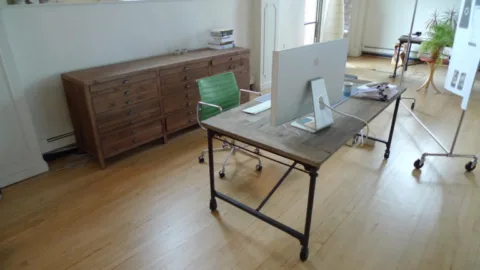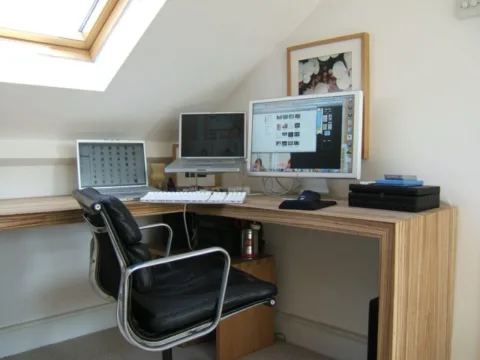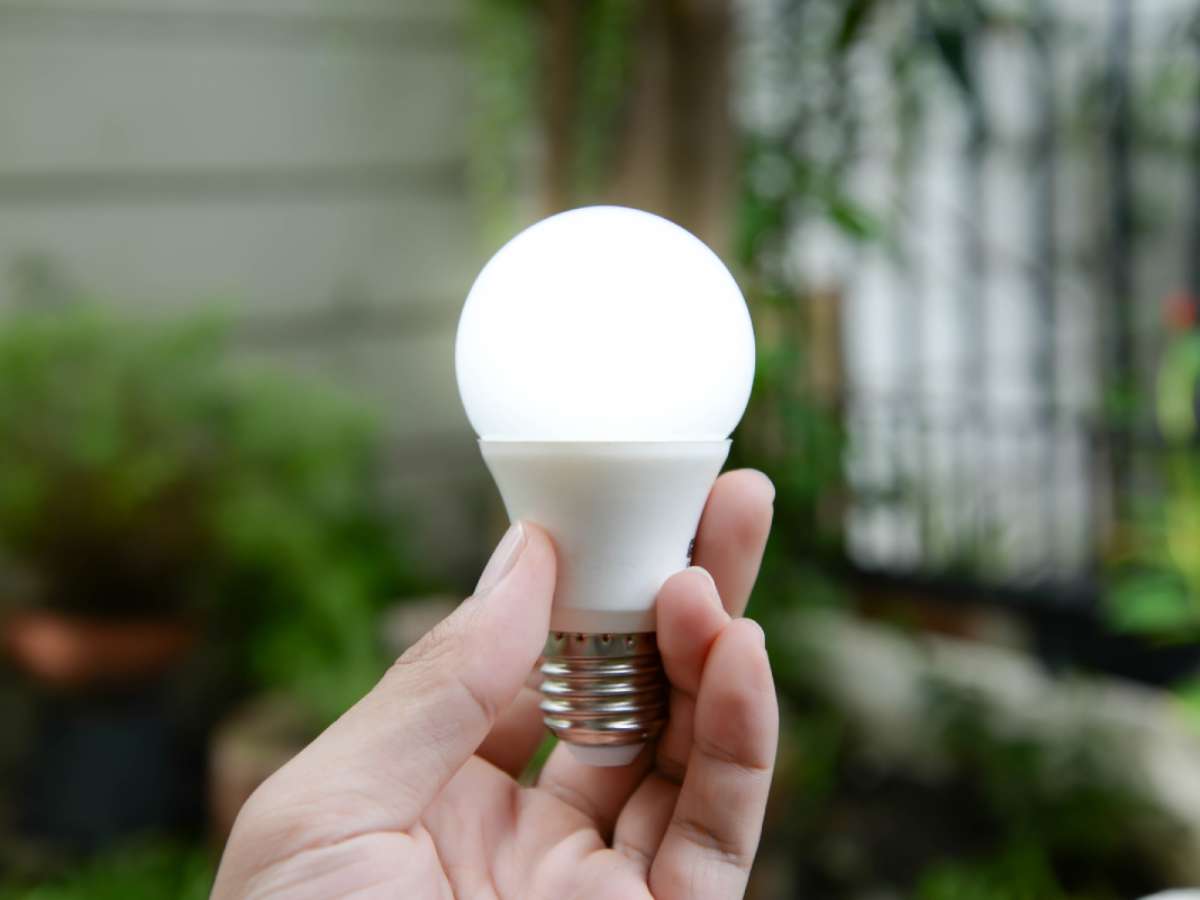Making a home office eco-friendly is a topic we’re hearing more often than ever these days.
It might have something to do with the growing trend toward people working at home. According to a recent study, 37% of U.S. workers reported they have telecommuted or worked at home.
I also work from home on a full-time basis as a journalist, reporter, and author.
Environmentally Friendly Home Office Tips
When you work from a corporate office, you’re usually inclined to recycle and go green due to company policies that encourage employees to be environmentally friendly. Therefore, it’s relatively easy to reduce your impact on the environment when it’s a company-wide practice.
But how can you stay green while working from home?
That’s a great question — one I’m about to help you answer with the 5 tips I’ve been using to stay environmentally friendly in my own home office.
#1 – Use Energy-Efficient Lighting
This is a pretty basic tip that is really easy to implement but all too often forgotten.
Replacing incandescent light bulbs with either compact fluorescent lighting (CFL) bulbs or light-emitting diode (LED) bulbs can help you significantly reduce your energy consumption and thus lighten (ha ha, I’m a punster) your load on the environment.
To give you an idea about the cost savings, the annual operating cost is $32.85 a year for LED bulbs, $76.65 a year for CFL bulbs, and $328.59 for incandescent bulbs. Here’s a handy chart comparing the energy efficiency, environmental impact, and light output of LEDs vs CFLs vs Incandescents
I use CFL bulbs in my home office ceiling fan light, a fluorescent tube in a 1960s-era desk lamp that I have next to my computer, and an LED light bulb illuminates a drawer next to my desk.
#2 – Buy Recycled Furniture
Remember that old desk lamp I just mentioned in the previous paragraph? And that drawer I talked about a moment ago?
They’re both recycled pieces of furniture that I inherited from my parents and continue using in my home office today.
While I bought a couple new pieces of furniture, I reused recycled furnishings whenever I could in building my home office to help reduce my impact on the environment.
Using recycled furniture in my home office also allowed me to save money — otherwise scarce funds that I used to build other aspects of my freelance business. (Hello, new computer!)
Recycled office furniture typically costs 30% to 50% less than new furniture. Once you figure out how much money you can save, buying another company’s discarded furniture begins to sound like a pretty good idea. Source
By the way, I still have the typewriter I used when I was a budding grade-school age writer. I simply couldn’t toss out my old, beloved typewriter.
Yes, dumping it into the trash would’ve meant it would take up valuable space in a landfill. But that wasn’t all I was worried about. You see, I’m simply too nostalgic to part ways with my typewriter!
I’ll always hang on to it no matter how technologically advanced electronic writing methods become in the future. I just hope I’ll still be able to find typewriter ink ribbons for it down the road. Hmm…
#3 – Reduce And Recycle Paper
Given that I use a computer and no longer employ a typewriter in my daily work, you’d think I generate little, if any, paper waste these days. Surprisingly, I use almost as much paper now as I did when I wrote my manuscripts and reports on my Smith-Corona typewriter decades ago.
Today, I use paper mainly for taking interview notes, drafting up story sketches on the run, and making up to-do lists and itineraries.
While I can’t totally eliminate paper from my daily duties, I can certainly do 2 things to help mitigate my impact on the environment due to my paper usage:
- Use both sides of the paper when writing
- Write about more than just a single subject on one sheet of paper
That latter point — expanding the number of subjects on a single piece of paper — has been critical for me, as I habitually avoided writing about more than one topic or idea on a sheet of paper up until the past year or so.
Call it a quirk, because that’s exactly what it was — a big ol’ paper-wasting quirk.
As for writing on both sides of the paper, not only does that reduce the amount of paper you use by approximately 50%, but it also helps you save money on buying notebooks!
Of course, in addition to all that, by recycling paper that I’m ready to dispose of helps to keep the environment clean, too. I keep a pile of paper that I plan to recycle near my desk and deposit that at a paper recycling center whenever I can.
#4 – Buy ENERGY STAR Electronics
I guarantee that 1960s-era desk lamp in use near my laptop isn’t an ENERGY STAR-rated appliance. But almost every other electronic in my home office is.
ENERGY STAR products are those that have been rated by the United States Environmental Protection Agency (EPA) as meeting certain energy-efficient requirements.
The popular ENERGY STAR program began in 1992 and has gone a long way toward reducing energy consumption and, in the process, helping to save the environment.
More energy-efficient electronics have allowed more Americans to save money on their power bills, too.
For example, if you purchased all of the following ENERGY STAR products for your home office, here’s an estimate of how much you would save on your utility bills annually… and during the life of the product(s):
- Computer & Monitor: $49 a year… $194 lifetime
- Laser Printer: $21 a year… $106 lifetime
- Scanner: $9 a year… $35 lifetime
- Fax: $10 a year… $41 lifetime
- TOTAL: $89 a year… $376 lifetime
In case you’re wondering, other types of ENERGY STAR office products include laps, phones, audio/video equipment, and network devices.
#5 – Open Your Windows To Reduce Electricity
One of my personal favorite ways to work is with open windows.
I never could open the nearest window in the 4th-floor office where I once worked — back when I was a member of corporate America.
But I can open the window in my home office any time I want! And, yes, that’s exactly what I do.
I love the fresh air — it seems to assist me in thinking more clearly over my myriad writing assignments.
But opening the window in my home office also helps me save a significant amount of money on the utility bill, providing I shut the central heating or air conditioning system off when the window is open.
Shutting off the air or heat and opening a window can easily shave 5% or 10% off your energy bills. And that, in turn, means you’re putting less strain on your power company and the resources it uses to deliver electricity to your home.
Of course, some power companies don’t use oil, gas, or coal — many use hydro energy, wind energy, or solar energy. But, even still — why waste electricity, no matter how it’s made?
So, open that home office window of yours whenever the weather is tolerable. You’ll enjoy breathing in the fresh air and saving more of your hard-earned work-from-home income — while helping keep your office green will surely make you feel better, too!
More Eco-Friendly Home Office Tips
- Fluorescent Light Bulb Recycling Made Easy
- How To Go Green In Your Home Office
- 20 Years Of ENERGY STAR Products Saving Americans Money
- Go Green In Your Home Office With These Easy Tips
- How Your Home Office Can Help You Go Green
- 7 Ways To Go Green In Your Home Office









